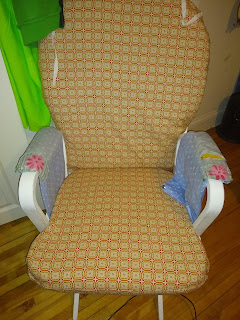I belong to a few international Facebook groups for sewists who make upcycled creations. A few weeks ago, a fellow sewist posted a picture of a garden apron with pockets she made. I immediately thought, "I need something like that." I am always setting tools down while gardening and then losing them. I still haven't found a pair of pruners I set down in our strawberry patch several months ago. My spouse went out and purchased a replacement pair, which is not very eco-friendly.
The first thing I needed was a pattern or model. I looked at a couple kitchen aprons we owned and didn't love their shape. Then I went online. I found some patterns that used flowery quilting fabric. I wanted something a little more durable. Then happened upon this apron pattern from Sew4Home. I liked the idea of durable and the split skirt. Sew4Home has a more detailed pattern and instructions if you want to make yourself the more traditional way. What I will do is to tell you more about how to make an upcycled version of this apron.
I started with two pairs of jeans offcast by my neighbors. One was darker blue and had more useable fabric and the other pair was lighter and a little more worn.
The pattern called for starting with a big 20 X 31 inch rectangle. I didn't have a piece of denim that large so I had to piece it together. On the darker pair, I cut the pant legs off just below the ripped area. I used the seam ripper to take apart the flat felled seams. I could have cut the seams but I was in a seam ripper mood. I kept the inside serged seams intact. I also used the seam ripper to detach a couple of the pockets and belt loops.
I was left with two pieces of flat fabric that were not square. I pressed the two pieces then pinned them together right sides together and serged them together on the diagonals with what was the bottom of the jeans facing in opposite directions. After serging I unfolded the fabric and pressed the fabric so it laid relatively flat
I wanted moderate cutesiness with this apron so I cut flower, carrot and leaf shapes from the denim to form applique. I used a fine zig zag stich to attach them to the pocket or the apron it self. I stitched the applique onto the base in a random order (some before I started sewing on the skirt, some after) because it was the fun part and I was alternately wrestling with my serger and sewing machine so sometimes I would be frustrated and switch to a task that I could do on the other device.
I deviated from the pattern and did my own thing with the pockets, topstitching two of the existing pockets on and also adding a few beltloops to hang sharper tools, I put a small piece of denim on the back to add some stabilization to the belt loop areas. For the bottom pockets I used the bottom of the pantleg and and part of the seam on another leg and another piece of fabric.
In order to sew the bottom rectangles onto the top ones, I used a four thread serged stitch instead of the flat felled seam called for in the pattern.
To hem the apron, I serged to finish the edges and folded over once and topstiched. The pattern calls for folding twice and my machines are just not industrial enough for too many layers of denim. For a more fitted item of clothing, you might have to do some calculations on how this will affect the size, but this was an apron so I didn't really care, I wasn't in the mood to piece together the fabric for the ties because my denim wasn't long enough so I went into my stash and found bias tape that would work. I sewed that on using a box pattern.
You can see a picture of me using the garden apron. This project was a family breakthrough because my spouse said he wanted one too, but in a more masculine pattern.
P.S. After I used the apron I decided I am going to add some belt loops toward the sides of the apron to better accommodate longer tools.









































